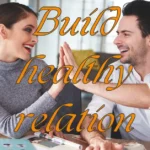Relationships are the foundation of our happiness and well-being. Whether it’s with a partner, a close friend, or a family member, we all crave connections that bring joy, understanding, and support. However, in a world full of distractions and misunderstandings, how do we ensure that our relationships remain healthy and strong? The secret lies in building habits that nurture trust, open communication, and emotional closeness.
Imagine a relationship where both people feel valued, heard, and appreciated—sounds amazing, right? These kinds of connections aren’t just a dream; they’re achievable with the right effort and mindset.
Ready to learn the essential steps for building healthy relationships that last? Let’s dive in!
Essential Steps for Building Healthy Relationships
Now that we understand what creates a healthy relationship, here are some practical tips for nurturing these connections:

- Practice Active Listening: When your partner is speaking, focus on what they are saying without interrupting. Show genuine interest in their thoughts and feelings, and respond thoughtfully.
- Set Boundaries: Establishing clear boundaries helps maintain a healthy dynamic. Discuss and agree on what is acceptable and what isn’t, ensuring that both partners feel comfortable.
- Express Appreciation: Regularly express gratitude for your partner’s efforts and qualities. A simple “thank you” can go a long way in making them feel valued.
- Learn to Compromise: No two people are alike, and disagreements are natural. Learning to compromise and finding middle ground can help resolve conflicts without resentment.
- Prioritize Self-Care: Taking care of your own mental and emotional well-being is crucial for a healthy relationship. When you’re happy and fulfilled as an individual, you can bring positivity into your connections.
- Seek Help When Needed: If you find yourselves struggling with certain issues, consider seeking help from a therapist or counselor. Professional guidance can provide valuable insights and strategies for improving your relationship.
What Creates a Healthy Relationship?
Key Components of Building Healthy Relationships

- Trust: Trust is the bedrock of any relationship and is crucial for building healthy relationships. It allows individuals to feel secure and open with one another. Building trust takes time and consistent actions, such as keeping promises and being honest. When trust is established, partners can share their thoughts and feelings without fear of judgment, creating a deeper emotional connection.
2. Communication: Open and honest communication is vital in building healthy relationships. Effective communication involves not just speaking your mind but also actively listening to your partner. According to a study from the Journal of Marriage and Family, couples who communicate openly experience higher satisfaction in their relationships. This two-way street of sharing and listening fosters a sense of understanding and unity.
3. Respect: Each partner should respect the other’s feelings, opinions, and boundaries. Respect is essential for building healthy relationships, as disrespect can erode trust and lead to conflict. It’s important to acknowledge and appreciate the differences that each person brings to the relationship, allowing both individuals to thrive.
4. Empathy: Empathy plays a significant role in building healthy relationships. It allows partners to understand each other’s feelings and perspectives. By putting yourself in someone else’s shoes, you can foster a deeper connection and resolve conflicts more effectively. Empathetic responses can bridge gaps in understanding and encourage emotional intimacy.
5. Quality Time: Spending quality time together is essential for building healthy relationships. Engaging in activities like going for a walk, having dinner, or enjoying shared hobbies strengthens bonds. Quality time allows partners to reconnect and enjoy each other’s company, reinforcing the foundation of trust and communication in the relationship.
The Importance of Healthy Relationships
.png?v=3c0980c9-14e6-40a9-8076-02a037f713b1)
Healthy relationships contribute significantly to our mental and emotional health. According to a study published in the American Journal of Psychiatry, individuals with strong social support systems tend to experience lower rates of depression and anxiety. Furthermore, a report by the National Institute of Health states that healthy relationships can even boost physical health, reducing the risk of chronic diseases.
Personal Experience:
Reflecting on my own life, I’ve seen how meaningful relationships can shape one’s outlook. After going through a challenging phase, I found solace in connecting with friends who provided support, understanding, and encouragement. Their presence not only helped me navigate tough times but also enhanced my overall happiness.
The 4 A’s of a Healthy Relationship
To further enhance your understanding of building healthy relationships, let’s delve into the 4 A’s that can significantly contribute to a thriving partnership:
- Acceptance: Embrace each other’s flaws and strengths. Accepting your partner for who they are fosters a sense of belonging and safety in the relationship.
- Appreciation: Regularly acknowledge and express gratitude for your partner’s contributions. Whether it’s a small gesture or a major accomplishment, appreciation reinforces positive feelings.
- Affection: Physical and emotional affection are essential components. Small acts like holding hands, hugging, or verbal affirmations of love strengthen emotional bonds.
- Attention: Be present in your relationship. Give your partner your undivided attention, especially during conversations. This shows that you value their thoughts and feelings.
The 5 C’s to Developing Healthy Relationships
Building healthy relationships is also about incorporating the 5 C’s that can enhance your connection:
- Communication: As mentioned earlier, effective communication is crucial. Regularly check in with your partner about their feelings and experiences.
- Commitment: Show dedication to the relationship by prioritizing it in your life. Make time for each other and invest in nurturing your bond.
- Compromise: Understand that disagreements will arise. Approach conflicts with a willingness to find solutions that work for both partners.
- Connection: Create emotional intimacy by sharing experiences, thoughts, and dreams. Engaging in shared activities fosters a deeper connection.
- Care: Show love and support in practical ways. This could include helping each other with tasks, being there during tough times, or simply checking in regularly.
Long-Term Relationships: How to Keep the Spark Alive

Long-term relationships can sometimes fall into a routine, but maintaining excitement and passion is possible. Here are some strategies to keep the spark alive:
- Try New Activities: Explore new hobbies or activities together. This can be anything from cooking a new recipe to taking a dance class. New experiences can reignite the excitement in your relationship.
- Plan Regular Date Nights: Set aside time for regular date nights to focus solely on each other. It doesn’t have to be extravagant—simple outings can help maintain the connection.
- Surprise Each Other: Surprise your partner with small gestures, like leaving sweet notes, planning a spontaneous day out, or cooking their favorite meal.
- Reflect on Memories: Take time to reminisce about special moments you’ve shared. This can strengthen your bond and remind you of the reasons you fell in love.
- Stay Physically Intimate: Physical affection is crucial in long-term relationships. Keep the romance alive by prioritizing intimacy, whether through cuddling, kissing, or exploring new aspects of your physical connection.
How to Solve Relationship Problems Without Breaking Up
.png?v=e7f6a063-d20d-495e-a831-43f975f6a4db)
Conflict is a natural part of any relationship, but knowing how to resolve issues without breaking up is key to building healthy relationships. Here are steps to effectively navigate challenges:
- Identify the Root Cause: Before addressing a conflict, understand what is truly bothering you. Often, the surface issue may mask deeper feelings that need to be addressed.
- Use “I” Statements: When discussing issues, use “I” statements to express how you feel without blaming your partner. For example, instead of saying “You never listen,” try “I feel unheard when we talk.”
- Stay Calm and Respectful: Approach discussions with a calm demeanor. Avoid yelling or name-calling, as these behaviors can escalate conflicts.
- Take Breaks if Necessary: If emotions are running high, take a break to cool down. Return to the discussion when both partners feel ready to engage constructively.
- Focus on Solutions: Instead of dwelling on problems, brainstorm potential solutions together. Collaborate to find compromises that work for both of you.
What Guys Want in a Long-Distance Relationship
Long-distance relationships can be challenging, but understanding what partners want can help bridge the gap. Here are some insights into what guys often seek in long-distance relationships:
- Trust and Security: Trust is paramount. Knowing that each partner is committed to the relationship alleviates anxiety and fosters a sense of security.
- Frequent Communication: Regular check-ins through calls, texts, or video chats can help maintain emotional intimacy. Guys often appreciate knowing that their partner is thinking of them.
- Shared Goals: Discussing future plans together can create a sense of purpose in the relationship. Whether it’s planning visits or discussing long-term aspirations, shared goals strengthen bonds.
- Flexibility and Understanding: Long-distance relationships require flexibility. Understanding each other’s schedules and being patient during tough times is essential.
- Physical Visits: Whenever possible, plan visits to see each other. These moments create lasting memories and reinforce emotional connections.
Are Long-Distance Relationships Worth It?
The question of whether long-distance relationships are worth it often arises. Here are some considerations:
- Communication Skills: Long-distance relationships often necessitate strong communication skills. Partners who work on this can strengthen their bond and enhance their relationship skills.
- Independence: Being apart allows both partners to maintain their independence and pursue individual interests. This can contribute to personal growth and satisfaction.
- Emotional Connection: The effort required in long-distance relationships can lead to a deeper emotional connection. Partners often learn to appreciate their time together more fully.
- Future Goals: If both partners are committed to eventually closing the distance, the relationship can be worth it. Having a shared vision for the future can provide motivation and purpose.
- Data Insights: A study published in the Journal of Communication found that couples in long-distance relationships reported higher levels of satisfaction compared to those in geographically close relationships. This suggests that the effort put into maintaining long-distance connections can be rewarding.
Getting Back Together After a Breakup
If you and your partner have broken up but are considering getting back together, here are some steps to consider:
- Reflect on the Past: Take time to reflect on the reasons for the breakup. Understanding what went wrong can help prevent repeating the same mistakes.
- Communicate Openly: If both partners are interested in reconciling, have an open and honest conversation about your feelings and intentions.
- Set Goals Together: Discuss what you both want moving forward. Establishing shared goals can provide a clear path for rebuilding the relationship.
- Seek Professional Help if Needed: Sometimes, couples may benefit from counseling to address deeper issues and facilitate communication.
- Take It Slow: Rebuilding a relationship takes time. Focus on building trust and reestablishing the emotional connection before rushing into things.
Conclusion
Building healthy relationships is an ongoing journey that requires effort, patience, and commitment. By focusing on the key elements of trust, communication, and respect, you can create meaningful connections that enrich your life. Remember to apply the practical tips shared in this article and remain open to learning and growing together.
Disclaimer: I am not a relationship expert. The information in this article comes from my own experiences and insights. For professional guidance, it’s best to consult a qualified relationship counselor or therapist.
1. What are the basic elements of a healthy relationship?
The basic elements of a healthy relationship include trust, communication, respect, empathy, and quality time together.
2. How can I improve communication in my relationship?
Practice active listening, express your thoughts openly, and regularly check in with your partner about their feelings.
3. Can long-distance relationships work?
Yes, with trust, commitment, and effective communication, long-distance relationships can thrive.
4. How do I resolve conflicts without breaking up?
Identify the root cause of the issue, use “I” statements, stay calm, and focus on finding solutions together.
5. What should I consider when getting back together after a breakup?
Reflect on past issues, communicate openly about feelings, and take time to rebuild trust before rushing into a relationship again.
By incorporating these insights and strategies, you’ll be well on your way to building healthy relationships that stand the test of time










